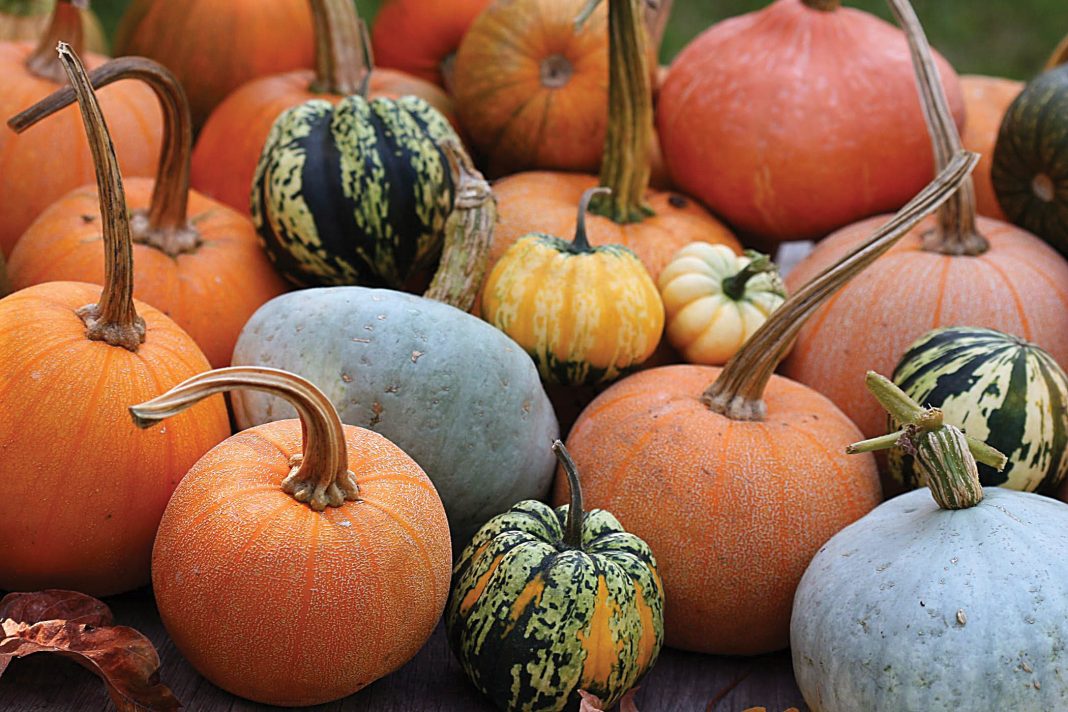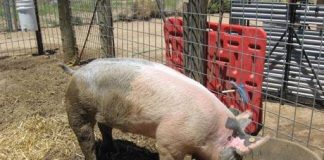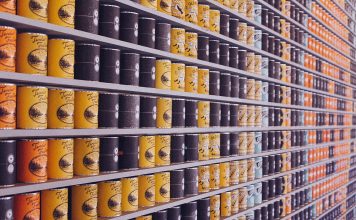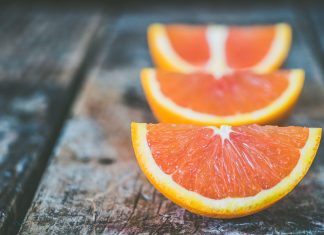By Lisa Nourse
I love summertime — I love the green of the trees, the warm weather, and growing my own food. I especially love growing vegetables that will store well and provide that great summertime flavor in the middle of our gray and dreary Pacific Northwest winters.
We can a lot of our summer crops but canned vegetables just don’t retain that fresh-picked flavor. So we use a variety of means in order to enjoy fresh vegetables year-round. By overwintering some crops in the garden (Swiss chard, kale, and spinach), growing microgreens inside, and growing crops that will store for long periods of time, we manage to keep a variety of fresh vegetables in our diet throughout the winter months.
Winter squash is one vegetable that stores well so we grow a few different ones for use during the colder months. Stored correctly, some winter squash (Hopi Pale Grey, Blue Hubbard, and sometimes Butternuts) will keep until the next season’s crop is ready to harvest.
Many vegetables and fruits prefer cooler temperatures for storage but not winter squash. I find that they keep better stored at room temperature. Winter squash come in all shapes, sizes, and colors. They are beautiful to look at so you can store them in plain sight all over the house. Arrange them in a corner next to a potted plant, make a table display, fill a wire basket or old wooden box, put them in a child’s wagon, line them up on the fireplace mantle — you get the idea.
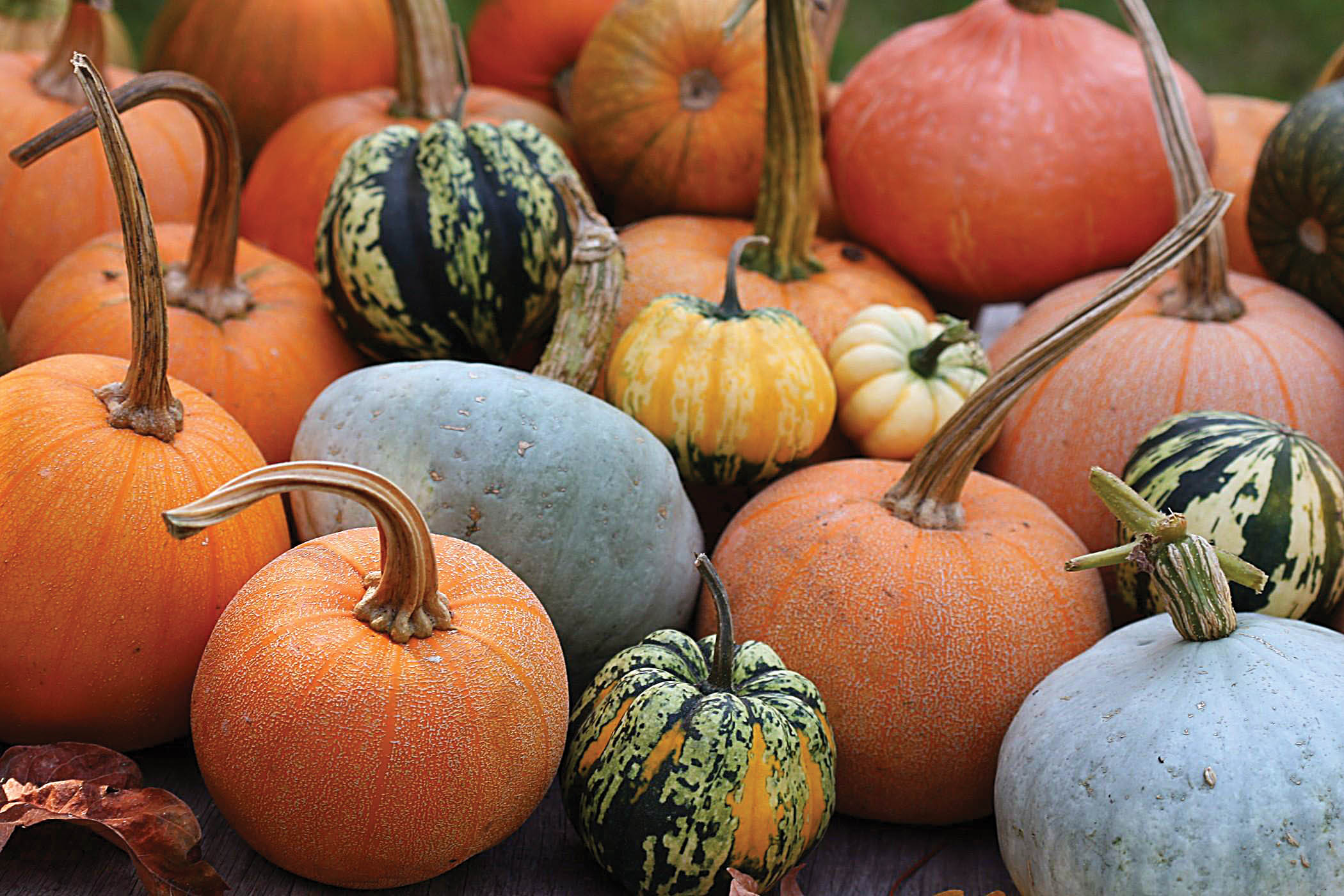
Here are a few of the different kinds of squash and pumpkins I like to grow.
Growing winter squash
Winter squash are fairly easy to grow but they require quite a bit of space. Fortunately, if you have a smaller garden there are some bush and semi-bush varieties that can be grown.
In addition to being delicious, most bush varieties mature faster than the larger vining types. A bush squash typically only takes up a 3×3-foot space. So you can fit three hills of squash (with 2-3 plants per hill) in a 6×6-foot area.
Semi-bush squash take up more room than the bush varieties but their vines remain shorter than the larger vining squash. They also have a tendency to produce a lot of fruit in the small amount of space they use.
If you are short on space think about growing a bush or semi-bush variety. Keep in mind though, because the foliage produces the sugars that feed the fruits, some bush and semi-bush varieties can be lacking on flavor. But there are some that are great. Here are a few of my favorites that we find have good flavor:
Bush Delicata
Cucurbita pepo, open pollinated. These oblong-shaped squash have creamy white skin with green stripes and flecks. The flesh is smooth and nutty flavored. The storage life of this squash is a little shorter than the harder-skinned varieties. I find they store well for about 3-4 months.
Baby Blue Hubbard
Cucurbita maxima, open-pollinated, semi-bush. This is a cross between a Blue Hubbard and a Bush Buttercup. The skin is blue and the flesh is golden-yellow with great flavor. These will store for a long time.
Emerald Bush Buttercup
Cucurbita maxima, open-pollinated, bush. This squash takes about 90 days to mature. It produces well and has a sweet yellow-orange flesh.
Burpee’s Butterbush
Cucurbita Moschata, open-pollinated, semi-bush. Earlier and shaped like a butternut but smaller than the Waltham Butternut. This squash has a sweet dense orange flesh and is nutty in flavor. These are good for long-term storage.
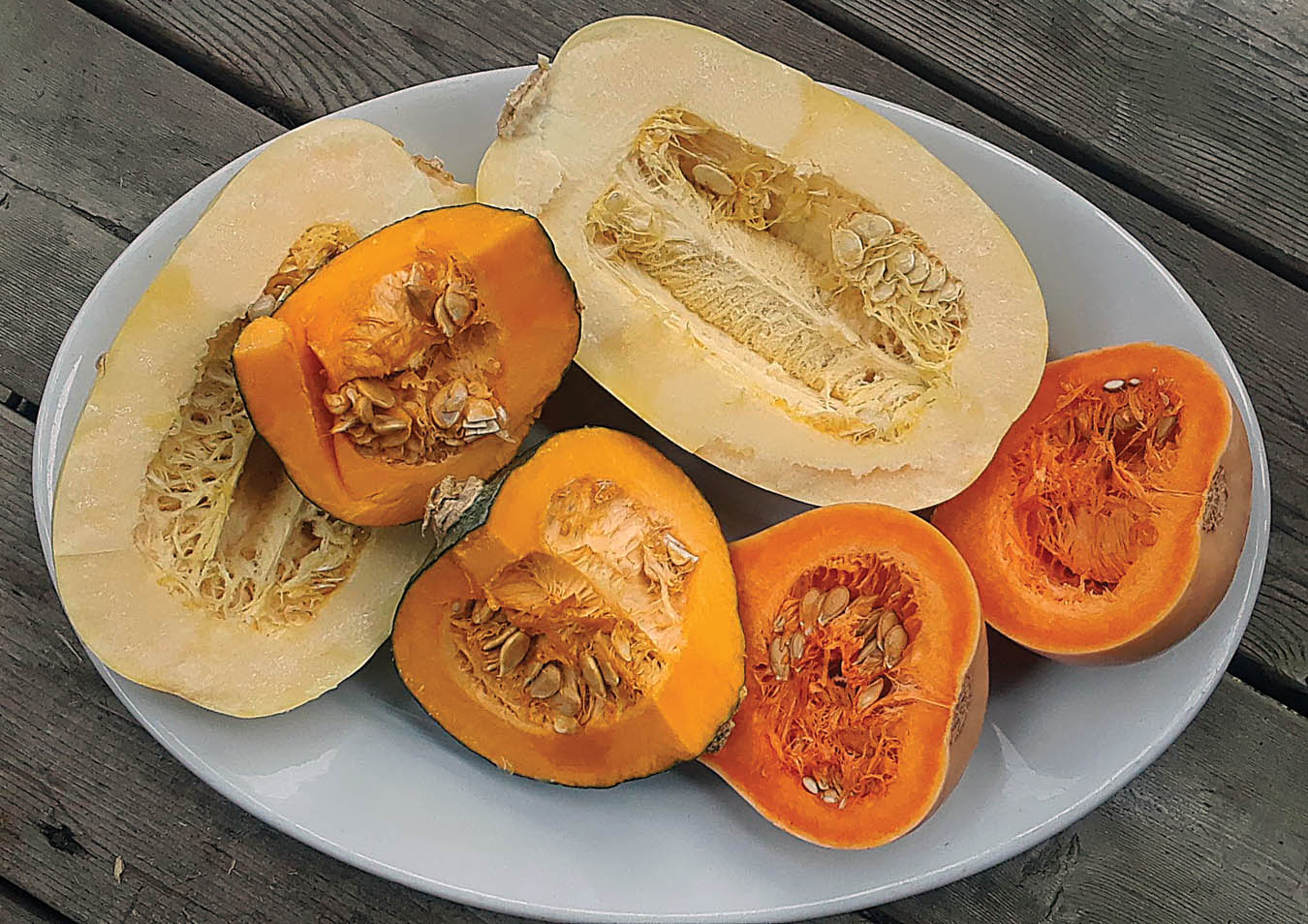
The flesh of winter squash ranges in color from pale yellow to deep red-orange and everything in between.
Kabocha
Cucurbita maxima, open pollinated, bush. Kabocha has a dark green rind and yellow to bright orange flesh. It tastes like a cross between sweet potato and pumpkin.
And here are a few of my favorite larger trailing-vine winter squash:
Hopi Pale Grey
Cucurbita maxima, open pollinated. This squash has a pale gray rind that is ridged and very hard which means it will store well for a long time. It has sweet orange flesh that is great for pies. The large vines are quite vigorous and will take over the whole garden if you are not careful where you plant them.
Sweet Meat
Cucurbita maxima, open-pollinated. This 10-15 pound gray round squash has a sweet rich flavor and stores well for a very long time. This is a longer-season squash (110 days) but worth it if you can handle it.
Magdalena Big Cheese
Cucurbita moschata, open-pollinated. These are large pale orange squash with a flattish pumpkin shape. They have a sweet very bright orange flesh.
Winter Luxury Pumpkin
Cucurbita pepo, open-pollinated. This is the best pie pumpkin I have found (introduced to me by Jackie Clay-Atkinson) and I grow it almost exclusively. It also makes a wonderful curried pumpkin soup. Fruits average 4-6 pounds. The rind is covered in delicate netting and the flesh is smooth and sweet. This pumpkin will keep for quite a while, but not all winter. I usually bake the pumpkins before they start to go bad, then turn the flesh into purée and freeze it.
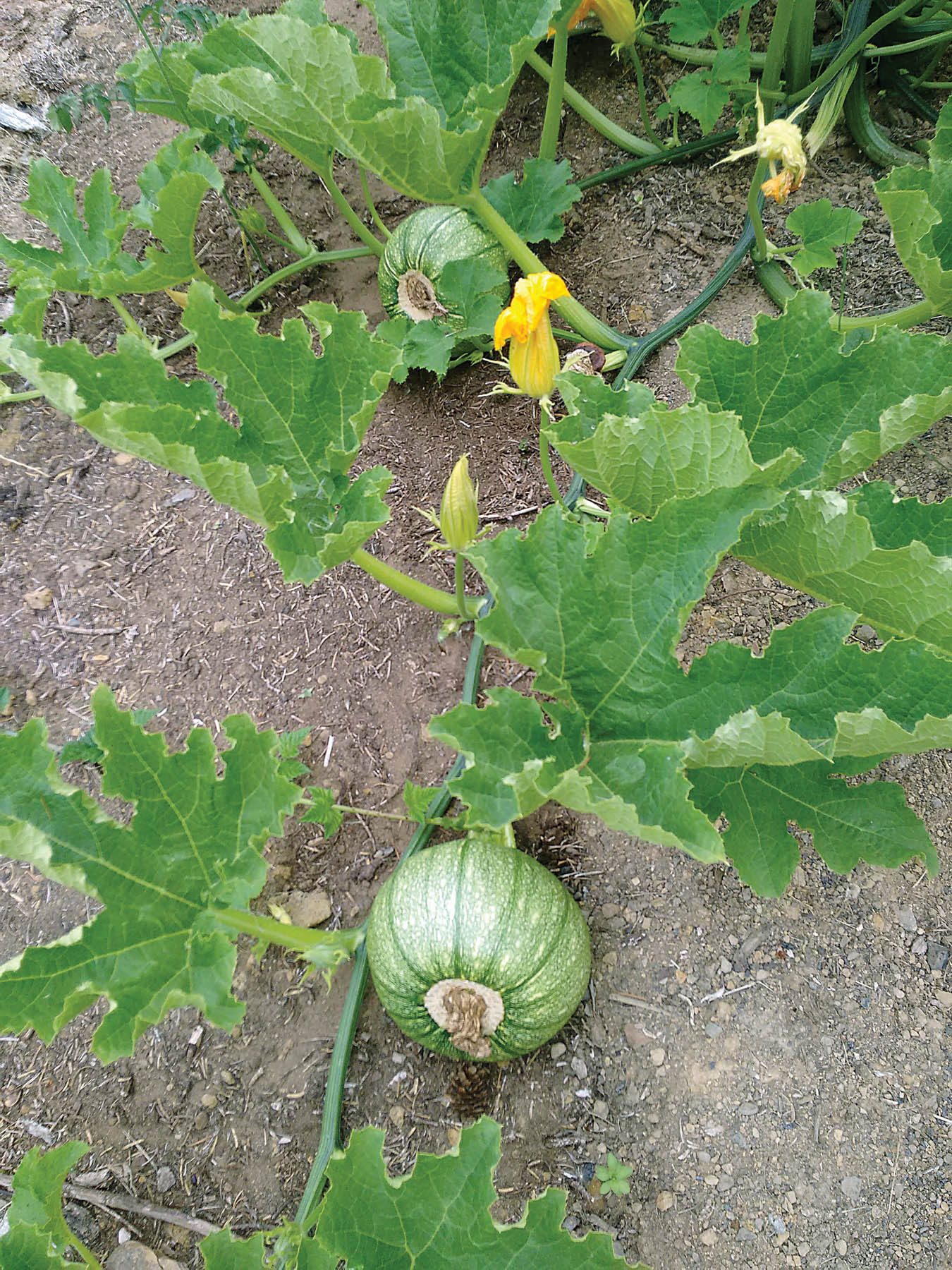
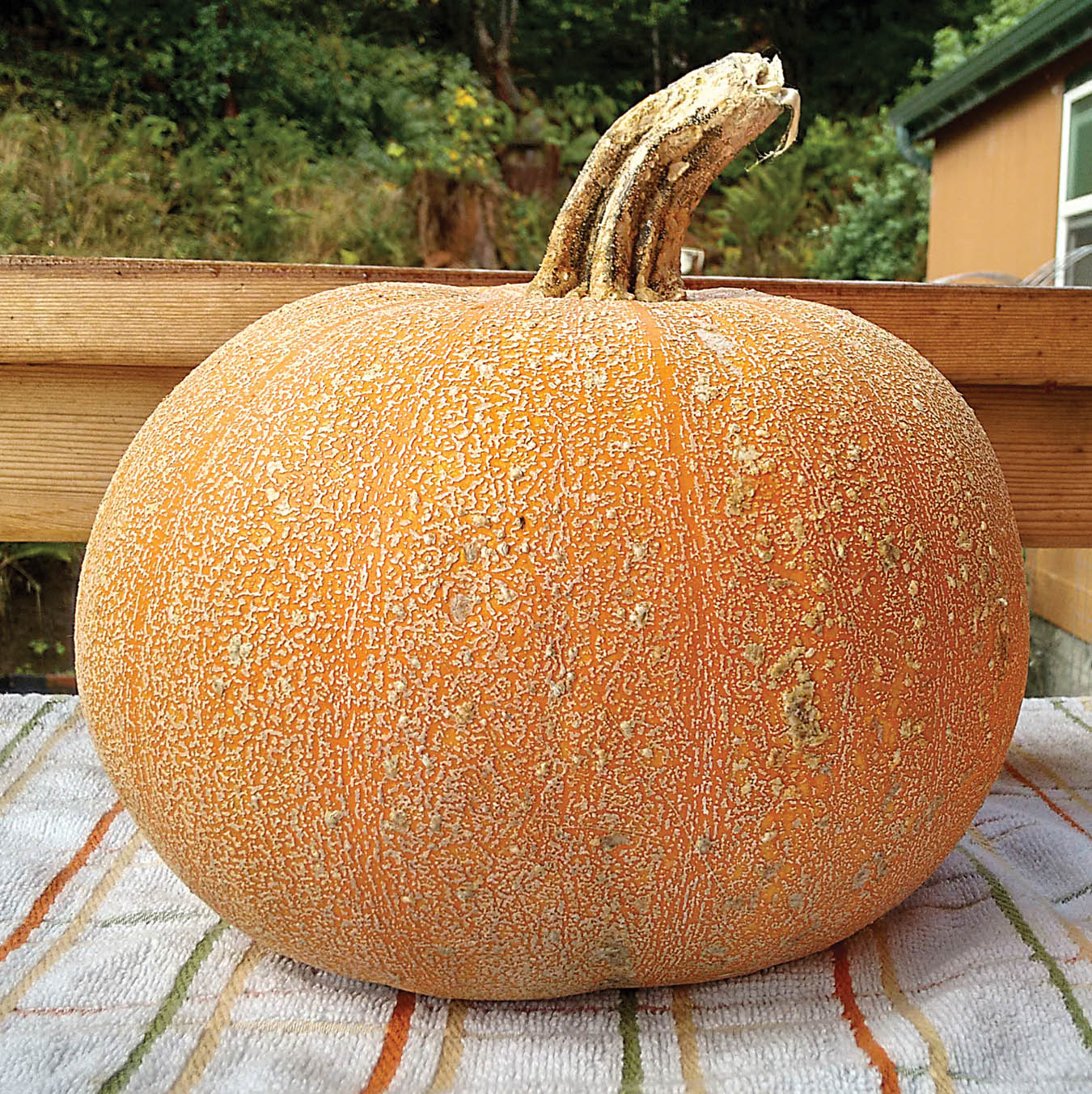
Winter Luxury pumpkin — immature on the vine and mature, ready for storage
Planting winter squash
Winter squash can be direct seeded after the threat of frost has past or they can be started indoors and transplanted later.
If using transplants, start the seeds indoors as early as four weeks before you want to plant them out in the garden. Harden them off before planting. Note: When transplanting squash or pumpkins in the garden, remember that they are a little finicky and don’t like their roots disturbed so be careful of that when setting them in the ground. Also, do not plant them deeper than they were in their original containers.
If you are direct seeding, plant your regular vining squash seeds about an inch deep in full sun in rows about six feet apart. Space the plants about 24 inches apart in each row. Since regular vining squash require so much room, they can be planted on the edge of the garden where their vines have more space to ramble and not take over other crops. The bush-type variety rows can be a little closer together. Or if you are like me and short on space, you can also grow bush-type squash in larger containers such as grow bags, plastic barrels cut in half, or any other large container with a depth and width of about 12-14 inches or larger. If you grow squash in containers be sure to check them daily to see if they need water.
Squash are heavy feeders
Winter squash are heavy feeders. They like a loamy soil with good drainage and lots of organic material that has a pH between 6.0 and 6.8. If your soil is acidic and lime is necessary, it is better to add it in the fall rather than right before planting as it can take several months before it makes a difference in the pH level.
I am a bit of a haphazard gardener so I have a tendency to just do what works for me rather than getting all technical about it. This is how I plant my squash: Before planting, I dig a hole and fill it with a mixture of manure and straw (I am careful to only use straw that has not been sprayed with an herbicide). I shovel in a bit of garden soil — maybe some compost — and turn it all together. Then I cover the mixture with a hill of garden soil and plant the seeds in that. Once the roots reach down into the manure and straw mixture, the plants really take off! With squash though, you have to be careful to go easy on the nitrogen or you’ll end up with lots of foliage but few fruits.
If you prefer to use commercial fertilizer granules, choose a well-balanced one such as 10-10-10 or 12-12-12. These numbers represent the percentages of nitrogen, potassium, and phosphate in the fertilizer mixture. Just scatter about a tablespoon of the fertilizer on the ground around the plant and water in well. Be careful not to let the granules touch the plants as it may cause them to burn. Use granular fertilizer about every 3-4 weeks throughout the growing season.
You can also apply a good compost tea every couple of weeks to fertilize your squash plants.
Squash like about an inch of water a week but just keep them damp when first planted or the seeds will likely rot. It’s better to water squash plants at soil level as overhead watering wets the leaves too much and will encourage diseases. If you must water overhead, do it in the early morning hours so that excess water will be evaporated by the sun before the cool temperatures of evening set in.
Squash plants have a tendency to wilt on hot days as they use water faster than the roots can supply. This is nothing to worry about if you are watering regularly and deeply. Wilted plants will perk up as the day gets closer to evening and the temperature cools down. Squash that is wilted in the morning needs to be watered right away.
You can mulch your squash plants but I do not because mulch hides squash bugs and cucumber beetles. Once the plants are off to a good start, their large leaves shade out most weeds anyway.
Stressed squash plants use sugars to keep living rather than sending it to the fruit. A healthy plant produces good fruit. A stressed plant will produce small, misshapen, tasteless fruit.
Male and female flowers
Squash have separate male and female flowers. The male flowers are usually the first to appear but they do not produce fruit. Female flowers appear a bit later. They have a “baby bump” of fruit on their stem and are pollinated by the male flowers with the help of bees and other insects. If pollination is slow or doesn’t seem to be happening, you can use a small soft-bristled paint brush and gently brush inside a male flower then carefully dust the inside of a female flower with the pollen collected.
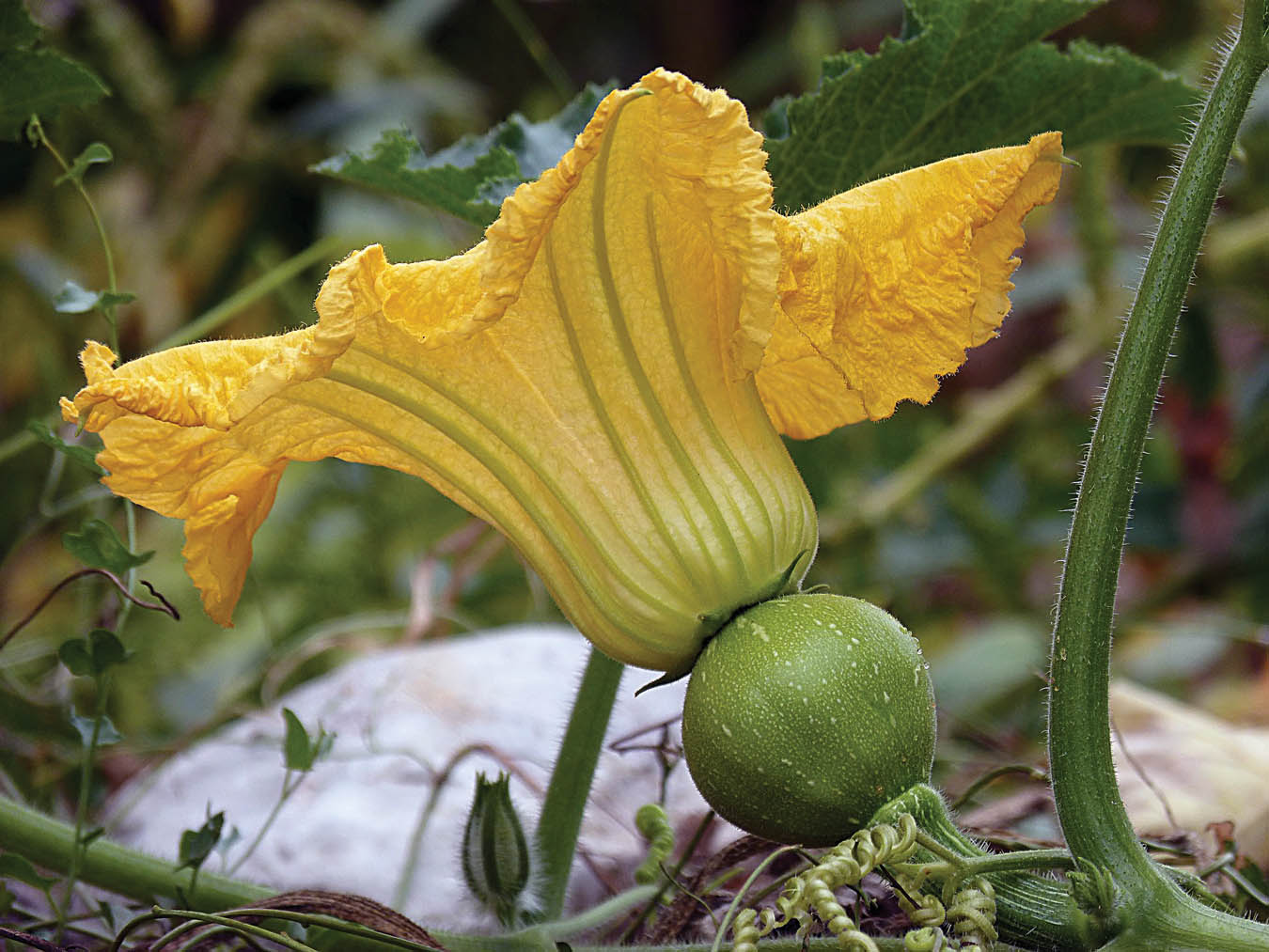
Female blooms have a “baby bump” of fruit on their stem.
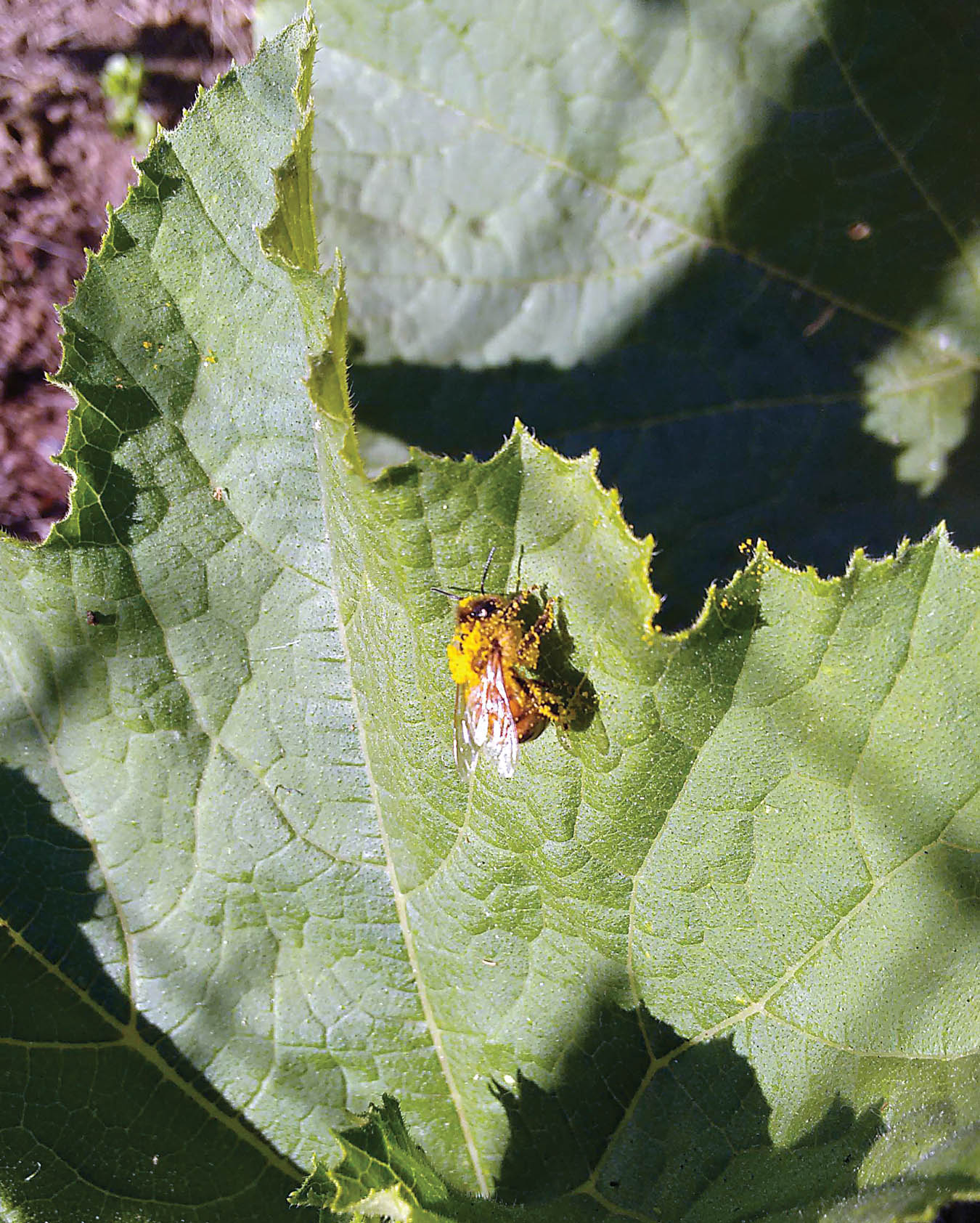
Here is a very pollen-heavy honeybee on a squash leaf. When applying insecticides for cucumber beetles or squash bugs, please do so in the evening after the bees have returned to their hives.
Pests and diseases
Squash are prone to attack by cucumber beetles (small striped or spotted yellow beetles), vine borers (a moth larvae), and squash bugs (flattish dark gray or brown insects that are about 5/8 inch long and have alternating orange and brown stripes on their abdomens).
Sometimes you can avoid these pests by planting at the right time. Another method is starting your plants indoors and transplanting them out in the garden when they are large enough that the munching pests won’t harm them as much.
So far I have not had to deal with squash bugs or vine borers but I have had a problem with cucumber beetles the last two years. Because I prefer to garden organically, I hand pick cucumber beetles a couple of times a day (or I pay the grandkids to do it). If you have a real problem and feel you must use an insecticide, please use it in the evening when bees have returned to their hives. Always avoid applying insecticide in the morning as this might kill bees that are necessary for pollination.
You can trap squash bugs by laying out boards or cardboard. The bugs will hide under the boards at night. Check traps first thing in the morning and dispatch any bugs you find.
A small hole in the stem or wilting that isn’t due to dryness may indicate the presence of squash borers. Slit the stem, remove the borer, and dispose of it. Cover the damaged stem with soil to encourage root development from that area — this doesn’t always work but is worth a try.
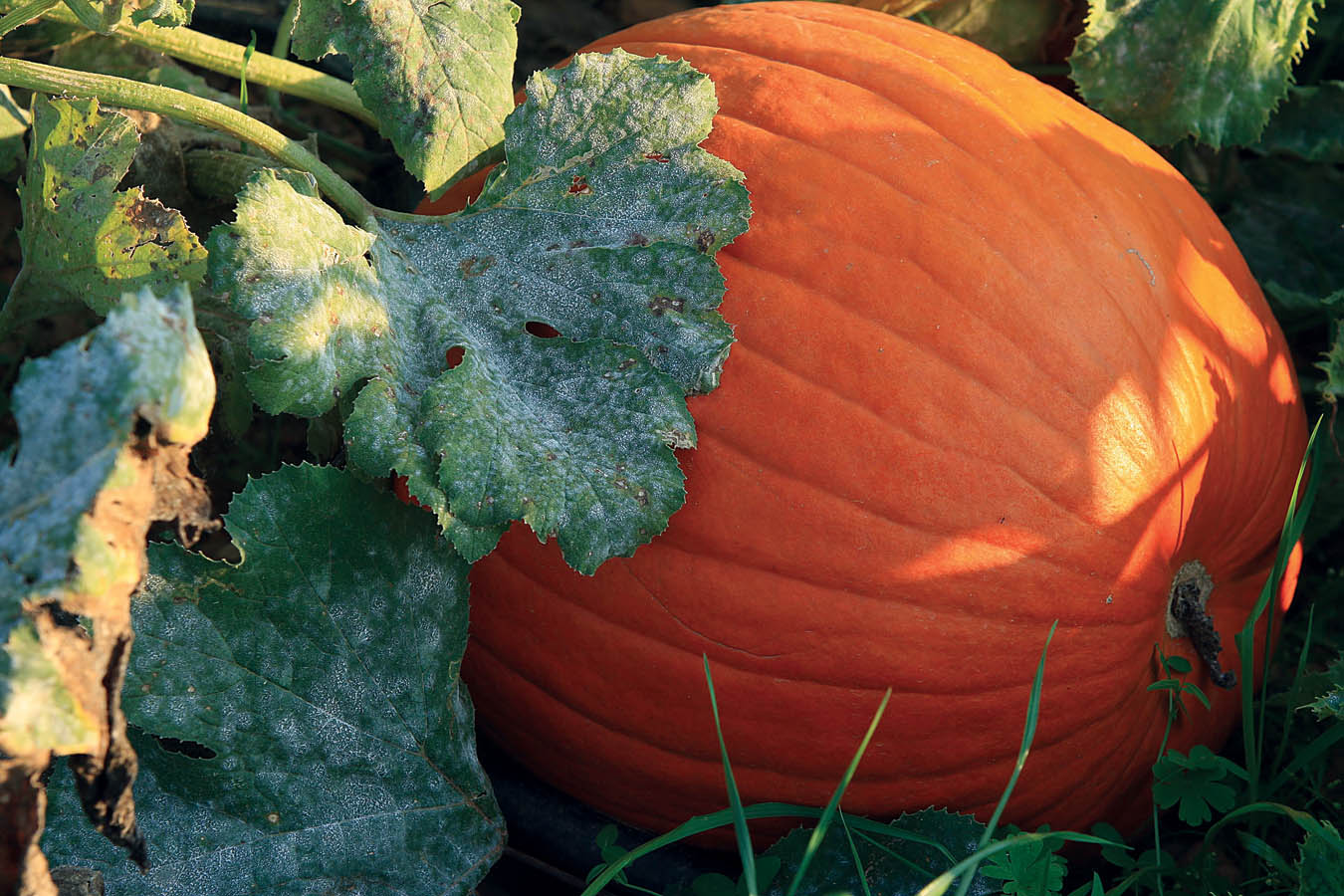
Powdery mildew is affecting the leaves of this pumpkin plant.
Bacterial wilt can also cause squash plants to suddenly wilt even though they are not dry. Bacterial wilt is spread to squash by cucumber beetles. Plants will show wilting of the leaves that eventually spreads until the whole plant has wilted.
There is nothing to be done about this problem once it sets in — the whole plant needs to be removed and burned or taken out with the trash. Never put diseased plants in your compost pile and never leave them laying in the garden.
To prevent bacterial wilt you must take care of the cucumber beetle problem.
Powdery mildew is a fungus disease. It causes the leaves to turn a gray-white color. Usually this happens late in the season so I don’t worry about it too much. I just make sure to remove the plants and burn them as soon as I have harvested all of the squash. However, if it becomes a real problem in your garden you can treat it by combining a teaspoon of baking soda and a quart of water in a spray bottle. Shake it up so all of the baking soda is dissolved. Spray each infected leaf every morning until the mildew spots go away. This only works if the problem hasn’t gotten too bad — once the powdery mildew has infected every leaf fully I don’t think there is anything that can be done about it. Also stop any overhead watering. You can space your plants a little farther apart next year and try growing them in a different area as the powdery mildew can overwinter in the soil.
Mosaic virus can cause squash plants to become stunted and turn a mottled yellow color. Mosaic virus is frequently seed-borne and also spreads by aphids and cucumber beetles. To control this virus, you must control the aphids and beetles, and then remove and burn affected plants.
Blossom end rot will cause squash fruit to rot from the blossom end and can be caused by infrequent watering which does not allow the plant to take up enough calcium from the soil. Water evenly and regularly and mulch around plants to conserve soil moisture. You can also use a calcium-rich foliar spray.
Blossom end rot can also be caused by low soil pH or plant stress due to unusually cold or hot weather, drought, or overly wet soil.
How to tell if your squash are ready to harvest
The rind of winter squash changes color (usually from a light color to a dark color or from green to another color altogether) and hardens up when they are ready to harvest.
If you are unsure if your squash are ready to harvest, you can check the rinds using your thumbnail. Try to poke your thumbnail into a squash. If the squash is ripe, your nail will not leave an indent. If you can cut the rind with your thumbnail, leave the squash on the vine and allow it to continue to ripen.
You can also give your squash a gentle rap with your knuckles. Winter squash have a hollow sound when they are mature and ready to pick.
Squash that is picked too soon will not have good flavor and will not store well. That being said, don’t wait too long to harvest your squash as frost and freezing temperatures will damage the fruits and reduce storage ability. If you have a few immature squash left on the vine and a freeze is forecast, you can either cover them or go ahead and harvest them. Immature squash are edible but they will not be as sweet as a fully mature and cured squash. They won’t last in storage. Use any immature squash as soon as possible.
Harvesting squash
The first step to successful winter storage is harvesting your squash the right way.
Don’t be in a hurry to harvest your winter squash — if harvested at the right time, handled carefully, and stored properly, you can enjoy your squash all winter and often longer.
To harvest squash, cut it from the vine with a sharp knife or a pair of pruners. Don’t pull or try to twist the squash free from the vine or you might break the stem away from the fruit reducing the amount of time the squash can be stored. Likewise, don’t carry your squash by the stem as this might also break it off. Leave a couple inches of the stem attached to the squash if possible. Be careful not to damage or bruise the squash since this will also decrease the amount of time you can store it.
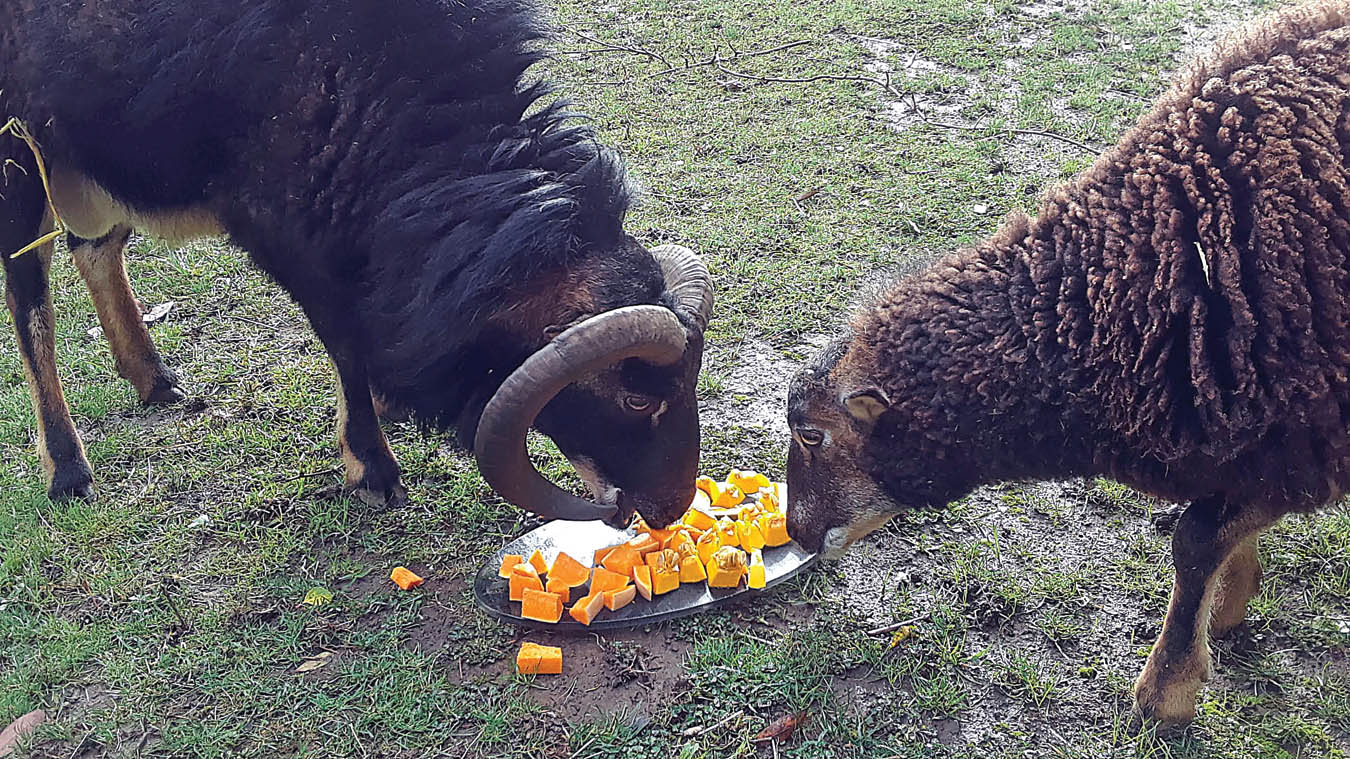
Our Soay sheep love pumpkins and squash. Here are a couple of them having a treat of Butternut and Kabocha squash chunks. (Yes, they are a bit spoiled!)
Storing your squash
For the best flavor, allow the squash to cure outdoors for a couple of weeks after picking. If it’s raining, or if there is a threat of freezing temperatures, a covered area is best. If you have any squash that are missing their stems, or that are damaged in any way, use them first.
You can store most winter squash for six months or longer in the proper conditions. I have found that winter squash keep best at room temperature (between 60 and 70 degrees). Avoid a moist or humid environment and, as long as you have the space, try to avoid stacking them too deeply. Sometimes I pile my squash up for display, however, stacked squash might get bruised which will lead to rot that you may not see.
Since different varieties of squash store for different lengths of time, be sure to check stored squash periodically for any that need to be used right away. If they are starting to lose quality and you are not going to preserve or use them right away, they can be fed to chickens or livestock. Our sheep love pumpkins and squash.
Saving seeds
Being able to save any squash seed is challenging if you do not have acres and acres of property. Varieties of the same species will cross easily but crossing between the different species does not occur. You will need to separate varieties of the same species by at least half a mile if you want true-to-type seed. If you do not have the space to separate like species you can collaborate with friends and neighbors or you can isolate plants from each other through the use of isolation tents and hand pollinate them. The isolation tents can be removed once the fruit has set.
Another method of saving true-to-type seeds (which is the one I use) is to only grow one variety of each species per year. You might be worried that you will miss out on some great squash by doing this, but it is not as limiting as you might think. Since there are five species of Cucurbita, (C. moschata, C. mixta, C. maxima, C. pepo, and C. argyrosperma) that’s five different types of squash you can grow that won’t cross pollinate. Since squash seeds will stay good for several years, the next year you can pick out five more different types to grow. This way you can save seed from more types of squash and have more variety in your seed inventory. The only glitch for me in using this method is that we like so many different kinds of C. pepo that I usually just buy fresh seeds each year.
Processing the seeds for storage is easy. Scoop the seeds and guts out of a mature squash. Rinse the seeds and, using your fingers, remove any strings and fibers. Spread the seeds out in a single layer on a cookie sheet, sop up any extra water with a paper towel, dry, and store in a cool dark place.
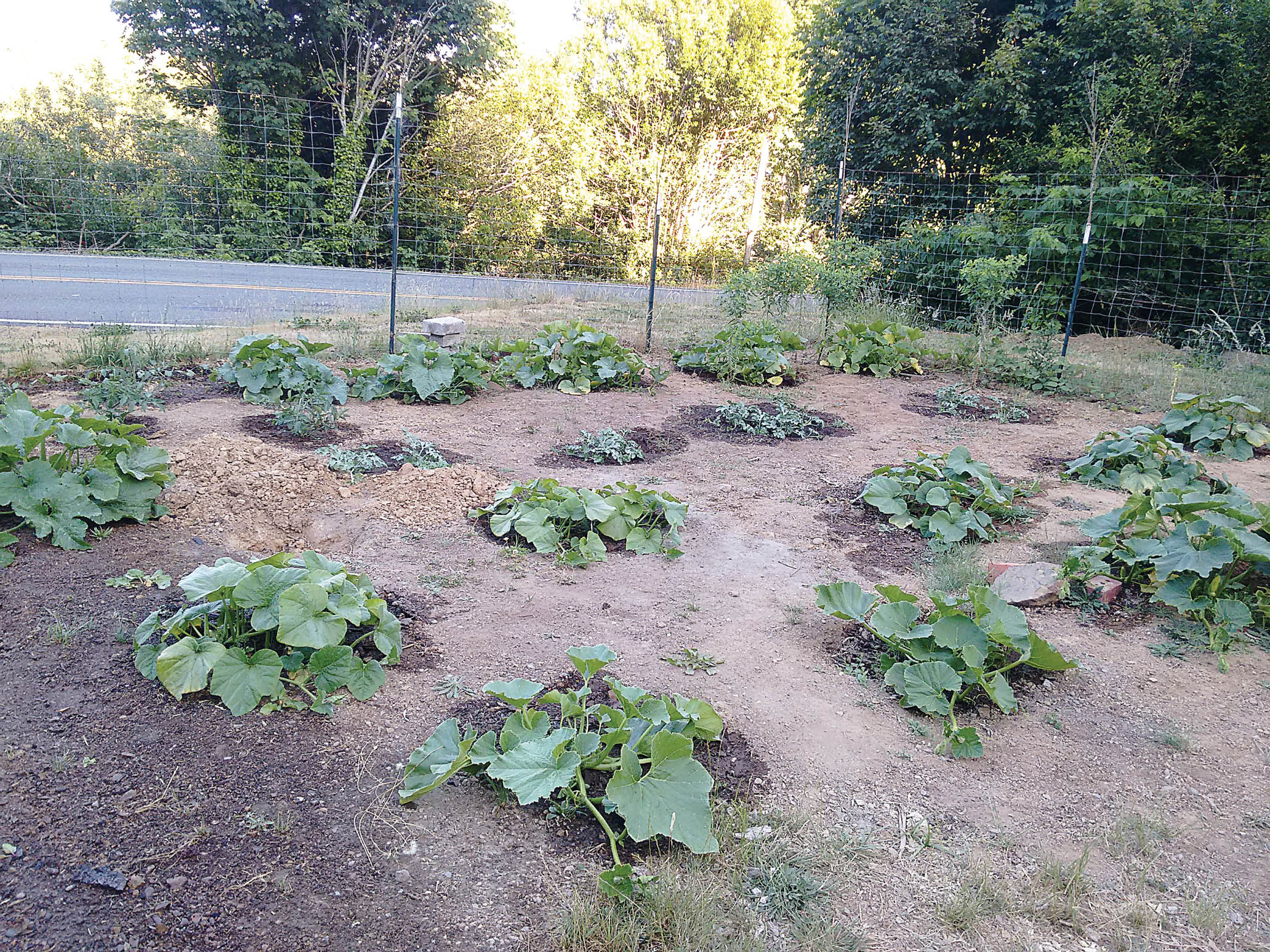
This is our small pumpkin/squash/watermelon patch. The soil in this spot is horrible red clay so we dug large holes and put good amended soil in them before planting.
Using winter squash
From curried butternut squash soup, cinnamon squash muffins, roasted squash stuffed with a mixture of kale, sausage, and rice, and all the way to pumpkin pie — winter squash is versatile and can be used in so many different sweet and savory recipes. (Check out Jim Capossela’s article in this issue for delicious ways to cook up your winter squash.)
If you have the room, growing an excess of winter squash and pumpkins can help with livestock feed expenses. Chickens, sheep, goats, cows, and pigs all love pumpkins and winter squash. The storage ability of winter squash and pumpkins means you can feed your livestock these treats all winter long. Just break them open and toss them over the fence. Your livestock will thank you.


